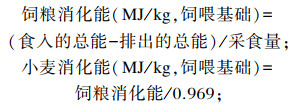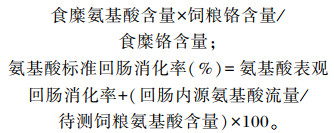2. 大兴安岭农林科学院, 大兴安岭 165000;
3. 中国农业科学院饲料研究所, 农业农村部饲料生物技术重点实验室, 北京 100081;
4. 山东大学环境科学与工程学院, 青岛 266237
2. Daxinganling Academy of Agriculture and Forestry Sciences, Daxinganling 165000, China;
3. Key Laboratory of Feed Biotechnology of Ministry of Agriculture and Rural Affairs, Feed Research Institute, Chinese Academy of Agricultural Sciences, Beijing 100081, China;
4. Shandong Provincial Key Laboratory of Water Pollution Control and Resource Reuse, School of Environmental Science and Engineering, Shandong University, Qingdao 266237, China
受“新冠”和“非瘟”双疫情的影响,玉米价格持续上升,小麦市场稳中有跌,越来越多的饲料企业和养猪企业将小麦作为能量饲料替代玉米。长期储存的小麦不适合作为人的口粮,其消费用途应转向饲料与工业[1]。因此,准确评价不同储存时间的小麦的饲用价值具有重要的意义。小麦的营养价值受众多因素的影响,如播种时间、加工方式、评价方法和种植环境等[2-6]。粮食收获后,在其自身的呼吸作用下,水分、淀粉和蛋白质等化学成分会发生变化,随储存时间的延长,易受到霉菌毒素的污染而无法作为人的口粮[7-9]。研究表明,饲粮中添加60%陈化玉米时,生长猪的生长性能和营养物质消化率与对照组相比没有显著差异[10]。陈化小麦生料酒精发酵的研究表明,与新收获小麦相比,陈化小麦同样适用于酒精生产[11]。然而,很少有研究评价不同储存时间的陈化小麦对于猪的营养价值。推进农业供给侧结构性改革,将陈化小麦作为饲料原料可以减少粮食在储存过程中所造成的经济损失,降低国家的财政负担,同时还可以缓解国家粮食储备压力,响应国家的储备粮“去库存”政策。因此,本试验拟评定不同储存时间小麦在生长猪上的营养价值,以期为其在生长猪饲料配方中的合理利用提供数据支持。
1 材料与方法 1.1 试验材料本试验中所用的小麦种植于河北省,于收获当年(2012、2013、2014、2015和2016年)入库河北省隆化县储备粮仓(河北省承德市隆化县357省道北侧;北纬41°72′,东经117°09′;温带季风气候),使用编织袋分袋封口包装(每袋40 kg),不同年份的小麦分别储存在不同的砖砌平房仓内,仓房内侧空间长15.8 m、宽11.2 m、高7.8 m,通风良好,储存条件符合相关国家标准[12]。小麦样品采集于2016年,所有小麦样品的采集均使用点收集法,每5袋作为1个取样单位,每个取样单位随机选择包装袋取样,得到样品约40 kg,混匀后缩样至30 kg。分别从10个不同取样单位采集不同储存时间的样品各300 kg,从中各取1 kg样品混合均匀后粉碎备用。剩余小麦样品混合均匀,运往动物试验基地进行动物试验。
1.2 试验设计和饲养管理试验1:采用完全随机试验设计,选取30头初始体重为(45.2±1.5) kg的杜×长×大三元杂交去势公猪,使用全收粪法进行消化试验。将30头猪按照平均体重相近的原则随机分配到5个试验饲粮处理中,每个处理6个重复,每个重复1头猪。5个小麦样品分别为5种试验饲粮中唯一的供能组分。通过直接法计算5个小麦样品的消化能和营养物质消化率。试验期共19 d:在正式试验前试验猪先于代谢笼中适应7 d,饲喂普通的生长猪全价饲粮;正试期12 d,饲喂试验饲粮,前7 d为预试期,后5 d为粪收集期。
试验2:采用6×6拉丁方试验设计,选取6头初始体重为(32.6±1.2) kg的装有简单T型瘘管的杜×长×大三元杂交去势公猪,分别饲喂1种无氮饲粮和5种小麦饲粮。饲粮中添加0.30%的三氧化二铬(Cr2O3)作为外源指示剂,通过指示剂法计算5个小麦样品的粗蛋白质和氨基酸的表观和标准回肠消化率以及淀粉的表观回肠消化率。试验共6期,每期持续7 d,其中前5 d为饲粮适应期,后2 d为食糜收集期。
动物试验在农业农村部饲料工业中心丰宁动物试验基地(河北承德九运农牧有限公司院士工作站)进行,按照农业部饲料效价与安全监督检验测试中心(北京)的猪饲料营养价值评价技术规程进行所有试验操作。试验猪放置于代谢笼(1.4 m×0.7 m×0.6 m)中,单笼饲喂,自由饮水。试验期间每天按照其初始体重4%的饲喂量进行饲喂,于每天08:30和15:30分2次等量饲喂。试验饲粮的营养水平参照《猪饲养标准》(NY/T 65—2004)[13]推荐值进行设计。试验饲粮的组成见表 1。
|
|
表 1 试验饲粮组成(饲喂基础) Table 1 Composition of experimental diets (as-fed basis) |
试验1采用全收粪法收集样品。粪收集期开始时,将收粪盘放置在猪笼漏缝板下,保证猪所排的粪全部落入收粪盘中。结束后将收集的粪进行称重,于65 ℃烘箱中烘72 h至风干状态,回潮24 h后至恒重,粉碎过60目筛,装袋备用。试验2在每期的第6天和第7天的08:00—18:00,使用橡皮筋将样品收集袋固定在瘘管上。每隔30 min更换1次收集袋以防止食糜发酵,换下的收集袋立刻转移到-20 ℃冰柜。试验结束后将每头猪在每一期的食糜混合,然后取500 mL使用冻干机进行真空冷冻干燥,最后放置于4 ℃储存室待检。
1.3.2 样品的分析样品中干物质、粗蛋白质、粗脂肪、总淀粉、粗灰分、铬和18种氨基酸含量分别按照GB/T 6435—2006[14]、GB/T 6432—1994[15]、GB/T 6433—2006[16]、GB/T 5009—2006[17]、GB/T 6438—2007[18]、GB/T 13088—2006[19]和GB/T 18246—2000[20]中方法测定;中性洗涤纤维和酸性洗涤纤维含量按照Van Soest等[21]报道的方法进行测定;总能按照国际标准ISO9831:1998推荐的方法使用氧弹式测热仪(Parr 6300 Calorimeter,美国)测定。使用配备荧光检测器(Agilent 1100,Agilent Technologies,美国)的高效液相色谱仪定量样品中的霉菌毒素含量。
1.4 计算公式消化能和营养物质表观全肠道消化率的计算公式参照Adeola[22],具体如下:

|
式中:0.969为小麦饲粮中小麦的添加比例。

|
猪饲粮中氨基酸表观和标准回肠消化率的计算公式如下[23]:

|

|
采用SAS 9.2统计分析软件,数据先用UNIVARITE程序进行正态性检验和异常值检测,然后用GLM模型对数据进行单因素方差分析。每1头猪作为1个试验单元,试验饲粮作为固定效应,用LSMEANS语句计算均值,差异显著时用Tukey法进行多重比较,采用正交多项式对比法(orthogonal polynomial contrasts)检测不同储存时间下小麦样品的线性和二次效应,P < 0.05为差异显著,0.05 < P < 0.10为有差异的趋势。
2 结果 2.1 不同储存时间小麦的理化指标由表 1可知,5个入库年份小麦中干物质、总能、淀粉、粗蛋白质、中性洗涤纤维、赖氨酸、蛋氨酸、饱和脂肪酸、不饱和脂肪酸和维生素E含量的变化范围分别为87.08%~88.60%、16.02~16.40 MJ/kg、60.46%~63.91%、12.37%~13.87%、10.44%~13.32%、0.33%~0.35%、0.20%~0.22%、5.62%~6.14%、17.23%~20.10%和6.52~13.30 mg/kg,其中2016年小麦中干物质、总能、淀粉、中性洗涤纤维、饱和脂肪酸、不饱和脂肪酸和维生素E含量最高,随储存时间的延长,小麦中维生素E含量降低。
2.2 不同储存时间对小麦消化能和营养物质消化率的影响表 3所示为不同储存时间小麦的消化能和营养物质消化率。5个入库年份小麦的消化能范围为14.06~14.43 MJ/kg。2015年小麦的消化能以及总能和中性洗涤纤维表观全肠道消化率显著高于其他年份小麦(P < 0.05),2015年小麦的粗蛋白质表观全肠道消化率显著高于2014和2016年小麦(P < 0.05),与2012和2013年小麦差异不显著(P>0.05)。储存时间的延长线性降低了小麦的淀粉表观回肠消化率(P=0.05),对消化能和其他营养物质表观全肠道消化率没有规律性(线性或二次)影响(P>0.05)。
|
|
表 2 不同储存时间小麦的理化指标(风干基础) Table 2 Physical and chemical indexes of wheat stored under different time (air-dry basis) |
|
|
表 3 不同储存时间小麦的消化能和营养物质消化率(风干基础) Table 3 DE and nutrient digestibility of wheat stored under different time (air-dry basis) |
表 4所示为不同储存时间小麦的氨基酸表观回肠消化率(AID)。2016年小麦的组氨酸表观回肠消化率显著高于2012和2013年小麦(P < 0.05),2015年小麦的亮氨酸和天冬氨酸表观回肠消化率显著高于2012和2013年小麦(P < 0.05),2015年小麦的赖氨酸和半胱氨酸表观回肠消化率显著高于2012、2013和2014年小麦(P < 0.05),2015年小麦的苯丙氨酸表观回肠消化率显著高于2013和2014年小麦(P < 0.05),2015年小麦的苏氨酸表观回肠消化率显著高于2012年小麦(P < 0.05),2015年小麦的色氨酸表观回肠消化率显著高于2012和2014年小麦(P < 0.05),2015年小麦的丙氨酸表观回肠消化率显著高于2012、2013和2016年小麦(P < 0.05),同时2013年小麦的丙氨酸表观回肠消化率显著低于其他年份小麦(P < 0.05),2012、2013和2015年小麦的甘氨酸表观回肠消化率显著高于2014和2016年小麦(P < 0.05)。
|
|
表 4 不同储存时间小麦的氨基酸表观回肠消化率 Table 4 Apparent ileal digestibility (AID) of amino acids of wheat stored under different time |
表 5所示为不同储存时间小麦的氨基酸标准回肠消化率。2016年小麦的组氨酸标准回肠消化率显著高于2012年小麦(P < 0.05),2015年小麦的亮氨酸和天冬氨酸标准回肠消化率显著高于2012和2013年小麦(P < 0.05),2015和2016年小麦的赖氨酸标准回肠消化率显著高于2014年小麦(P < 0.05),2015年小麦的苯丙氨酸标准回肠消化率显著高于2013年小麦(P < 0.05),2015年小麦的苏氨酸和丝氨酸标准回肠消化率显著高于2012年小麦(P < 0.05),2015和2016年小麦的色氨酸标准回肠消化率显著高于2012年小麦(P < 0.05),2015年小麦的丙氨酸标准回肠消化率显著高于2012、2013和2016年小麦(P < 0.05),同时2013年小麦的丙氨酸标准回肠消化率显著低于其他年份小麦(P < 0.05),2015年小麦的半胱氨酸标准回肠消化率显著高于2012、2013和2014年小麦(P < 0.05),2012和2015年小麦的甘氨酸标准回肠消化率显著高于2014和2016年小麦(P < 0.05)。
|
|
表 5 不同储存时间小麦的氨基酸标准回肠消化率 Table 5 Standardized ileal digestibility (SID) of amino acids of wheat stored under different time |
长期储存的粮食会发生一系列生理和生化变化,例如酶活性降低、结构松弛、化学成分发生变化等,储存不当还会导致霉菌毒素含量上升,从而影响其营养价值,无法作为口粮食用[24]。本研究测得的小麦样品的化学成分含量与NRC(2012)[25]中报道的数据接近,同时霉菌毒素含量符合国家标准《饲料卫生标准》[26]的规定,可以作为饲料原料使用。小麦与玉米的能量水平接近,同时有更高的粗蛋白质含量,以小麦作为能量饲料替代玉米还可以减少蛋白质补充料(如豆粕等)的使用,从而降低成本[2]。研究表明,储存不当时玉米比小麦更容易发生霉变,霉菌毒素含量超标会对猪和家禽产生很大的危害[24, 27]。因此,当玉米价格上涨时,陈化小麦可以作为能量饲料替代玉米的使用,合理利用陈化小麦可带来更多的经济效益。
研究表明,谷物中淀粉的结构会随储存时间的延长而方生变化。玉米储存超过2个月后,其支链淀粉含量会随储存时间的延长而降低,而直链淀粉含量则会升高;玉米储存超过6个月后,淀粉的峰值黏度和糊化焓变随储存时间的延长而降低,结晶度的百分比随储存时间的延长而增加[28-29]。本试验中,储存时间的延长线性降低了淀粉的表观回肠消化率,淀粉结构和类型的改变是导致其消化率发生变化的主要原因。郭盼盼[30]研究了小麦不同储存时间对育肥猪有效能值和营养物质消化率的影响,结果表明,与储存9和12个月的小麦相比,储存3~6个月的小麦对育肥猪的营养价值更高,同时发现小麦中性洗涤纤维含量随着储存时间的延长而升高,非淀粉多糖含量随着储存时间的延长而降低。以上研究的储存时间跨度为1年以内,本试验研究了储存时间超过1年时小麦的营养成分变化及生长猪对能量和营养物质的消化率随储存时间的变化,结果表明,储存时间未对小麦的化学组成、消化能和营养物质消化率产生规律性(线性或二次)影响。储存时间的跨度以年为单位是导致本研究结果与以上参考文献不一致的原因,正常储存时间超过1年以后,小麦主要的化学组成和有效能值不会发生显著的变化。储存时间是影响维生素稳定性的原因之一,本研究发现,随储存时间的延长,小麦中维生素E的含量降低。孔凡科等[31]研究发现,处理时间的延长显著提高了预混料中维生素E的损失率。使用陈化小麦作为饲料原料时,可以通过在预混料中添加维生素E来满足畜禽的营养需要。本研究发现,2014年小麦的赖氨酸消化率、2012年小麦的苏氨酸和色氨酸消化率低于其他年份小麦,针对这一情况,同样可以通过配料时补充外源氨基酸来满足猪的营养需要[25]。
由于采样量的限制,本研究并未通过大群生长试验探究陈化小麦对猪生长性能的影响。研究表明,饲粮中添加陈化玉米会降低仔猪的采食量,造成仔猪肝脏和空肠的氧化损伤[24],还会降低肉鸡的生长性能和肉品质[27]。很少有研究直接报道陈化小麦对畜禽生长性能的影响,笔者认为,与玉米相比,小麦更易储存,不易受到霉菌毒素的污染,因此陈化小麦比陈化玉米能发挥更大的营养价值。同时有文献报道,通过添加抗氧化剂或生物活性物质(如谷胱甘肽酵母粉)等可以缓解陈化玉米对畜禽生长的负面效应[32]。在使用陈化小麦作为饲料原料时,可以通过添加外源酶制剂或制粒处理缓解纤维和多糖的负营养作用,提高小麦的营养物质消化率和有效能值,进而促进猪的生长,达到最佳的饲喂效果[4]。
4 结论① 河北省国家粮仓储存的2012—2016年小麦对生长猪的消化能分别为14.16、14.16、14.06、14.43和14.06 MJ/kg。
② 对于河北省国家粮仓储存的小麦,收获后储存1年对于生长猪的营养价值最佳,超过1年后,小麦的营养价值降低。
| [1] |
王秀丽, 孙君茂. 中国小麦消费分析与未来展望[J]. 麦类作物学报, 2015, 35(5): 655-661. WANG X L, SUN J M. Status and outlook of wheat consumption in China[J]. Journal of Triticeae Crops, 2015, 35(5): 655-661 (in Chinese). |
| [2] |
ROSENFELDER P, EKLUND M, MOSENTHIN R. Nutritive value of wheat and wheat by-products in pig nutrition: a review[J]. Animal Feed Science and Technology, 2013, 185(3/4): 107-125. |
| [3] |
ZHAO J, TANG S, ZHOU X, et al. Determination of chemical composition, energy content, and amino acid digestibility in different wheat cultivars fed to growing pigs[J]. Journal of Animal Science, 2019, 97(2): 714-726. DOI:10.1093/jas/sky431 |
| [4] |
YANG Y Y, YF F, CAO Y H, et al. Effects of exogenous phytase and xylanase, individually or in combination, and pelleting on nutrient digestibility, available energy content of wheat and performance of growing pigs fed wheat-based diets[J]. Asian-Australasian Journal of Animal Sciences, 2017, 30(1): 57-63. |
| [5] |
KOO B, BUSTAMANTE-GARCÍA D, NYACHOTI C M. Energy content and nutrient digestibility of diets containing Lactobacillus-fermented barley or wheat fed to weaned pigs[J]. Journal of Animal Science, 2018, 96(11): 4802-4811. |
| [6] |
BOLARINWA O A, ADEOLA O. Direct and regression methods do not give different estimates of digestible and metabolizable energy of wheat for pigs[J]. Journal of Animal Science, 2012, 90(Suppl.4): 390-392. |
| [7] |
LABUSCHAGNE M, PHALAFALA L, OSTHOFF G, et al. The influence of storage conditions on starch and amylose content of South African quality protein maize and normal maize hybrids[J]. Journal of Stored Products Research, 2014, 56: 16-20. DOI:10.1016/j.jspr.2013.11.004 |
| [8] |
LIU K L, LI Y, CHEN F S, et al. Lipid oxidation of brown rice stored at different temperatures[J]. International Journal of Food Science and Technology, 2016, 52(1): 188-195. |
| [9] |
REHMAN Z U. Storage effects on nutritional quality of commonly consumed cereals[J]. Food Chemistry, 2006, 95(1): 53-57. DOI:10.1016/j.foodchem.2004.12.017 |
| [10] |
孙婉丽, 何健, 白雅绮, 等. 陈化玉米在生长猪上的营养价值评定[J]. 饲料工业, 2019, 40(14): 18-23. SUN W L, HE J, BAI Y Q, et al. Nutritional value assessment of aged corn on growing pigs[J]. Feed Industry, 2019, 40(14): 18-23 (in Chinese). |
| [11] |
王年忠, 赵二永, 王芳, 等. 陈化小麦生料酒精发酵的中试[J]. 食品与发酵工业, 2013, 39(4): 81-85. WANG N Z, ZHAO E Y, WANG F, et al. The pilot scale study on aged wheat ethanol production by no-cook technology[J]. Food and Fermentation Industries, 2013, 39(4): 81-85 (in Chinese). |
| [12] |
中华人民共和国国家质量监督检验检疫总局, 中国国家标准化管理委员会. GB/T 7415-2008农作物种子贮藏[S]. 北京: 中国标准出版社, 2008. General Administration of Quality Supervision, Inspection and Quarantine of the People's Republic of China, China National Standardization Administration Committee. GB/T 7415-2008 Seed storage of agricultural crops[S]. Beijing: Standards Press of China, 2008. (in Chinese) |
| [13] |
中华人民共和国农业部. 猪饲养标准: NY/T 65-2004[S]. 北京: 中国农业出版社, 2004. Ministry of Agriculture of the People's Republic of China. NY/T 65-2004 Feeding standard of swine[S]. Beijing: China Agriculture Press, 2004. (in Chinese) |
| [14] |
中华人民共和国国家质量监督检验检疫总局, 中国国家标准化管理委员会. GB/T 6435-2014饲料中水分和其他挥发性物质含量的测定[S]. 北京: 中国标准出版社, 2014. General Administration of Quality Supervision, Inspection and Quarantine of the People's Republic of China, China National Standardization Administration Committee. GB/T 6435-2014 Determination of moisture and other volatile mater content in feeds[S]. Beijing: Standards Press of China, 2014. (in Chinese) |
| [15] |
国家市场监督管理总局, 国家标准化管理委员会. 饲料中粗蛋白测定方法-凯氏定氮法: GB/T 6432-2018[S]. 北京: 中国标准出版社, 2018. State Administration for Market Regulation, China National Standardization Administration Committee. GB/T 6432-2018 Determination of crude protein in feeds-Kjeldahl method[S]. Beijing: Standards Press of China, 2018. (in Chinese) |
| [16] |
中华人民共和国国家质量监督检验检疫总局, 中国国家标准化管理委员会. GB/T 6433-2006饲料中粗脂肪的测定[S]. 北京: 中国标准出版社, 2006. General Administration of Quality Supervision, Inspection and Quarantine of the People's Republic of China, China National Standardization Administration Committee. GB/T 6433-2006 Determinaiion of crude fat in feeds[J]. Beijing: Standards Press of China, 2006. (in Chinese) |
| [17] |
国家市场监督管理总局, 中国国家标准化管理委员会. GB/T 20194-2018动物饲料中淀粉含量的测定旋光法[S]. 北京: 中国标准出版社, 2018. State Administration for Market Regulation, China National Standardization Administration Committee. GB/T 20194-2018 Determination of starch in feeds-Polarimetry[S]. Beijing: Standards Press of China, 2018. (in Chinese) |
| [18] |
中华人民共和国国家质量监督检验检疫总局, 中国国家标准化管理委员会. GB/T 6438-2007饲料中粗灰分的测定[S]. 北京: 中国标准出版社, 2007. General Administration of Quality Supervision, Inspection and Quarantine of the People's Republic of China, China National Standardization Administration Committee. GB/T 6438-2007 Determination of crude ash[S]. Beijing: Standards Press of China, 2007. (in Chinese) |
| [19] |
中华人民共和国国家质量监督检验检疫总局, 中国国家标准化管理委员会. GB/T 13088-2006饲料中铬的测定[S]. 北京: 中国标准出版社, 2006. General Administration of Quality Supervision, Inspection and Quarantine of the People's Republic of China, China National Standardization Administration Committee. GB/T 13088-2006 Determination of chromium in feeds[J]. Beijing: Standards Press of China, 2006. (in Chinese) |
| [20] |
中华人民共和国国家市场监督管理总局, 中国国家标准化管理委员会. 饲料中氨基酸的测定: GB/T 18246-2019[S]. 北京: 中国标准出版社, 2019. State Administration for Market Regulation, China National Standardization Administration Committee. GB/T 18246-2019 Determination of amino acids in feeds[J]. Beijing: Standards Press of China, 2019. (in Chinese) |
| [21] |
VAN SOEST P J, ROBERTSON J B, LEWIS B A. Methods for dietary fiber, neutral detergent fiber, and nonstarch polysaccharides in relation to animal nutrition[J]. Journal of Dairy Science, 1991, 74(10): 3583-3597. DOI:10.3168/jds.S0022-0302(91)78551-2 |
| [22] |
ADEOLA O. Digestion and balance techniques in pigs[M]. AUSTIN J, LEWIS L, LEE S.Swine Nutrition.2nd ed.New York: CRC Press, 2000: 903-916.
|
| [23] |
STEIN HH, SōVE B, FULLER MF, et al. Invited review: amino acid bioavailability and digestibility in pig feed ingredients: terminology and application[J]. Journal of Animal Science, 2007, 85(1): 172-180. DOI:10.2527/jas.2005-742 |
| [24] |
李锦英. 饲粮添加陈化玉米和复合抗氧化剂对仔猪生长性能、抗氧化能力及肠道健康的影响[D]. 硕士学位论文. 雅安: 四川农业大学, 2018: 30-38. LI J Y. Effect of dietary aging corn and complex antioxidants supplementation on growth performance antioxidant capacity and intestinal health in piglets[D]. Master's Thesis. Ya'an: Sichuan Agricultural University, 2018: 30-38. (in Chinese) |
| [25] |
NRC. Nutrient requirements of swine[S]. 11th ed. Washington, D.C. : National Academy of Sciences, 2012.
|
| [26] |
中华人民共和国国家质量监督检验检疫总局, 中国国家标准化管理委员会. GB 13078-2017饲料卫生标准[S]. 北京: 中国标准出版社, 2017. General Administration of Quality Supervision, Inspection and Quarantine of the People's Republic of China, China National Standardization Administration Committee. GB 13078-2017 Hygienical standard for feeds[S]. Beijing: Standards Press of China, 2017. (in Chinese) |
| [27] |
董晓宇. 陈玉米特性及其在肉鸡日粮中的利用效果研究[D]. 硕士学位论文. 北京: 中国农业大学, 2018: 13-21. DONG X Y. Characteristics of stored corn and the effect of its utilization in broiler diets[D]. Master's Thesis. Beijing: China Agricultural University, 2018: 13-21. (in Chinese) |
| [28] |
STEPHEN S. Improving feed quality by proper processing of raw materials[D]. Master's Thesis. Ames: Iowa State University, 2010.
|
| [29] |
GURAYA H S, JAMES C, CHAMPAGNE E T. Effect of enzyme concentration and storage temperature on the formation of slowly digestible starch from cooked debranched rice starch[J]. Starch, 2001, 53(3/4): 131-139. |
| [30] |
郭盼盼. 储存时间和粉碎力度对肥育猪小麦有效能和养分消化率的影响[D]. 北京: 中国农业大学, 2015: 10-21. GUO P P. Effects of storage time and particle size on available energy and nutrient digestibility of wheat in fattening pigs[D]. Master's Thesis. Beijing: China Agricultural University, 2015: 10-21. (in Chinese) |
| [31] |
孔凡科, 郭吉原, 杨青, 等. 储存时间、铜源及其添加水平对脂溶性维生素稳定性的影响[J]. 中国畜牧杂志, 2020, 56(12): 129-132. KONG F K, GUO J Y, YANG Q, et al. Effect of storage time, copper source and supplemental level on stability of fat-soluble vitamins[J]. Chinese Journal of Animal Science, 2020, 56(12): 129-132 (in Chinese). |
| [32] |
罗斌, 乐科明, 陈代文, 等. 陈化玉米及谷胱甘肽酵母粉对断奶仔猪生长性能、养分表观消化率、血清抗氧化和免疫指标的影响[J]. 动物营养学报, 2019, 31(4): 1574-1584. LUO B, YUE K M, CHEN D W, et al. Effects of aging maize and glutathione yeast on growth performance, nutrient apparent digestibility, serum antioxidant and immune indices of weaning piglets[J]. Chinese Journal of Animal Nutrition, 2019, 31(4): 1574-1584 (in Chinese). |




